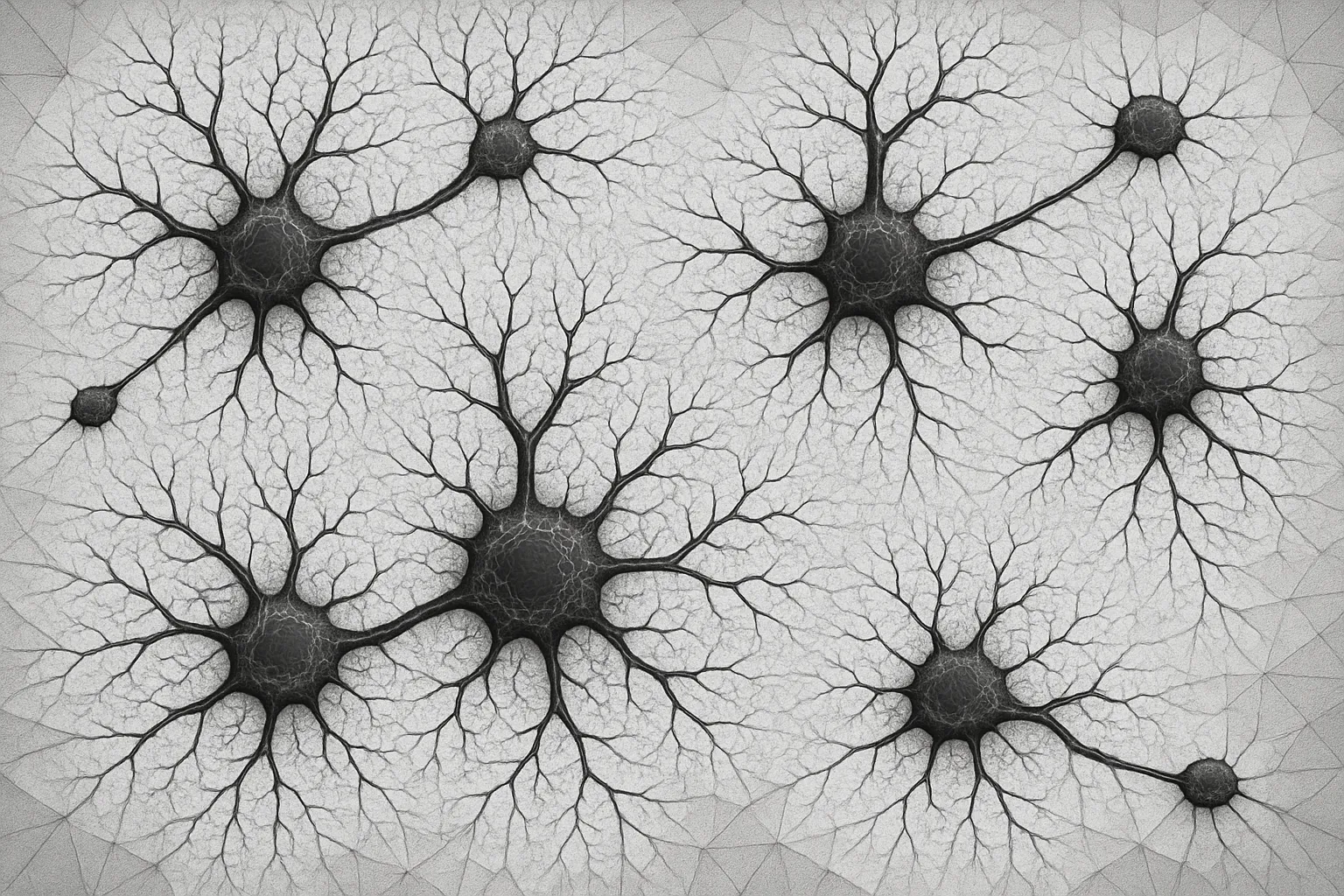The Dendritic Tree: Nature’s Fractal Computer and a Blueprint for Emergent AI
1. Basic Structure
A dendritic tree is the branching, tree-like extension of a neuron. It spreads outward from the soma (cell body) and serves as the neuron’s primary input system. Rather than being simple “wires,” dendrites are dynamic, fractal-like antennas—constantly growing, retracting, and fine-tuning themselves based on experience.
2. Function in the Brain
- Reception: Collects chemical signals from other neurons at synapses.
- Integration: Summarizes thousands of simultaneous inputs.
- Computation: Locally transforms signals through ion channel activity.
- Plasticity: Adapts structurally and functionally through dendritic spines.
3. Dendritic Spines
Tiny protrusions on dendrites where synapses form. They are not static: spines grow, retract, and shift their shape depending on learning, stress, or stimulation. Each one is a “learning switch,” modulating how information is stored.
4. Types of Dendritic Trees
Different neurons have characteristic dendritic geometries, optimized for their roles:
- Pyramidal neurons (cortex, hippocampus):
- Feature both apical dendrites (large branches extending upward toward the cortical surface) and basal dendrites (smaller branches surrounding the soma).
- This arrangement lets them integrate top-down feedback signals and bottom-up sensory input, making them central to memory and cognition.
- Purkinje cells (cerebellum):
- Possess one of the most elaborate dendritic trees in the brain—a flat, fan-shaped sheet of branches with tens of thousands of synaptic inputs.
- Designed for massive parallel input integration, crucial for motor coordination and learning.
- Interneurons:
- Typically have more compact and less branched dendritic trees.
- Suited for local computations and short-range communication, shaping network rhythms and inhibitory control.
- Retinal ganglion cells:
- Their dendritic fields vary in size depending on whether they process fine detail (small field) or broad visual patterns (large field).
- They demonstrate how dendritic geometry directly tunes perceptual resolution.
This diversity shows dendritic trees aren’t “generic”—their shape encodes functional intent.
5. Dendrites as Computational Units
Traditionally, neurons were modeled as single points summing inputs. This is now outdated. Dendrites are active computational modules:
- Nonlinear Processing:
Dendrites contain voltage-gated ion channels, NMDA receptors, and calcium dynamics that enable them to amplify or dampen signals. A dendritic branch can act like a “local decision unit.” - Branch-Level Logic:
Each branch can independently function as a logic gate:- AND gate: fires only when multiple inputs coincide.
- OR gate: fires when any one input is active.
- XOR-like filtering: passes one signal only when another is absent.
- Coincidence Detection:
Dendrites are tuned to time—sensitive to inputs arriving within milliseconds of each other. This temporal precision is critical for learning sequences, speech, and motor coordination. - Compartmentalization:
Instead of being a single pool of input, dendrites are compartmentalized. One branch may handle visual signals, another tactile feedback, another top-down expectation. The soma integrates these localized computations into a global decision.
In short: a single neuron is not one computing unit, but a forest of microcircuits.
6. Development and Growth
Dendritic trees expand and retract throughout life. Early in development, they grow explosively, guided by chemical gradients and activity patterns. In adulthood, experience sculpts them—enrichment fosters branching, while deprivation prunes it.
8. Metaphors and Systems Thinking
Dendritic trees resemble lightning, rivers, and root systems—optimized fractals balancing efficiency and coverage. They are living proof that intelligence is not centralized but emerges from distributed, recursive branching.
9. Computational Inspiration
This is where dendrites cross into digital biology and AI:
- Hierarchical Fractals:
Dendritic branching suggests a natural architecture for scalable computation—recursive fractal trees that integrate information at multiple resolutions. - Local Nonlinear Units:
Instead of current AI neurons (simple weighted sums), dendrite-like nodes could each host local logic functions. This would allow richer behavior with fewer parameters, mimicking how one neuron in the brain is a micro-network. - Time Sensitivity:
Dendrites act as millisecond-scale coincidence detectors. AI systems inspired by this could move beyond static tokens toward temporal precision processing, handling streams, sequences, and rhythms in real-time. - Contextual Filtering:
Just as different branches handle different inputs, an AI with dendritic-inspired architecture could route sensory streams, context cues, and memory retrievals into different “branches,” integrating them only when necessary. - Energy Efficiency:
Biological dendrites are massively efficient, doing localized processing without requiring the soma to fire. This is a key insight for neuromorphic chips, where energy bottlenecks dominate. - Multi-Resolution AI:
Imagine a network where some branches are tuned for fine-grained local features (edges, phonemes, words) and others for broad global patterns (scene, meaning, emotion). This reflects pyramidal neuron organization. - Digital Biology Parallel:
In your framework, dendritic trees could be modeled as branching compiler-organs: local code interpreters that preprocess input before forwarding to the “soma” core. Each branch could mutate independently, making the system robust, adaptive, and fractal.
✅ Summary:
The dendritic tree is not just a branching structure—it is the hidden computational engine of the brain. Different trees encode different roles (from the fine discrimination of retinal cells to the massive integration of Purkinje cells). Within each branch lies logic, timing, and adaptive microcircuits. For AI and digital biology, the dendritic tree is a roadmap: build systems that are fractal, locally intelligent, temporally sensitive, and energy-aware.
